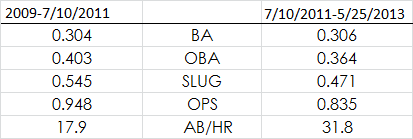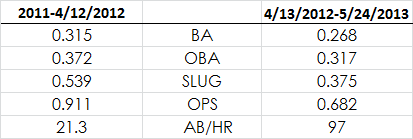Don Mattingly this weekend came out and stated what teammates, opposing players and managers understood—that Matt Kemp has not yet fully recovered from off-season reconstructive surgery. Two home runs and 17 on the morning of May 25 says it all about the 2011.
Kemp hasn't whined or complained, but Mattingly told Kevin Baxter of the Los Angeles Times. “He’s frustrated. The biggest thing we want to do with Matt is to try to keep the bat in the strike zone longer…when he’s going good he’s driving the ball to center, to right-center…I notice he’s cutting his swing off…if he’s top-spinning in left and left-center field, it tells me he’s getting extension to a certain point and he’s coming off just a little bit.”
Mattingly is not an orthopedic surgeon, but he is a PhD when it comes to hitting. Kemp has the finest in orthopedic care from Dr. Neal ElAttrache of the Kerlan-Jobe Orthopedic Center. While Dr. ElAttrache cannot discuss the specifics of Kemp’s recovery, he fully understands the complex significance of the shoulder in hitters.
“The importance of the shoulder in hitting is underestimated,” says Dr. ElAttrache. “What is particularly important is the lead shoulder.” Kemp missed nearly two months of the 2012 season with hamstring pulls and other issues, but on August 28 he suffered his most significant injury when he crashed into a fence in Colorado, He continued to play the rest of the season, but after the Dodgers were eliminated he underwent surgery to repair a torn labrum and some minor damage to the rotator cuff.
The labrum tear was in the front of his left shoulder, the lead shoulder as a righthanded hitter. Mattingly adds that Kemp will return to his star level once he’s healthy; Kemp loves the limelight, but he is one of the rare players who accepts every thing that goes along with stardom. But “health” is far more complex than weeks of rehab and training following labrum surgery.
“Trying to re-establish ones mechanics after surgery is a complex process,” says Dr. ElAttrache, speaking generally. “It’s extremely delicate. It involves rebuilding strength, and all that goes into the swing from the front shoulder. It takes perfect mechanics to regain bat speed and the swing path. Sometimes it takes a year, sometimes more.
“A player may think he is fully recovered, especially after all the work that rehab entails, but regaining the mechanics doesn’t come easily,” says the doctor. “Sometimes we can see a hitter opening up too quickly. He may step out with his front foot to catch up to pitches, and also so he doesn’t have to finish off his swing, which puts a great deal of pressure on the shoulder, especially the front of the lead shoulder.
“Sometimes those mechanics can be just a tick off, and they are hard to re-establish. I’m certain there are cases where the should is never exactly the same as before an injury or the gradual wearing down process. It is mechanical. It can be mental. For the hitter, a shoulder injury isn’t really any different that a shoulder injury can be for a pitcher.”
Adrian Gonzalez
Kemp’s rehab is obvious, and well-explained by Mattingly. But there are other cases that at least are worth a look.
One is Adrian Gonzalez. He had three remarkable seasons his last three years at Petco Park, averaging 32 homers. In 2009, he hit 40 homers with a .958 OPS. His lead shoulder had bothered him in 2010, and he had labrum surgery prior to being traded to the Red Sox, and after continuing his rehab process in spring training in Fort Myers, Fla., his numbers leading up to the All Star Break (.354, 17 HR, 1.006 OPS, .591 slug) not only got him to the game, but into the Home Run Derby.
However, after the break, Gonzalez was not the same power hitter. He batted .317 with 10 homers, but more significant, his slugging fell to .489, his OPS to .893. Some suggested that he had worked so hard to be ready for the season—and, yes, get a new contract deal struck during spring training—that he wore down and the shoulder lost some of its strength. He denied it, continually saying that he simply got mechanically out of whack. Because of that, he sometimes tried to look for pitches and got himself out of sorts.
Look at AGon's numbers through May 25, before and after:

Gonzalez has never offered physical excuses, only opined that he gets mechanically unturned. However, is that related to the lead shoulder never being the same? We may never know, and playing 81 games in Dodger Stadium and another 18 in Petco and Pac Bell parks do not help any power numbers. And Dr. ElAtracche points out that the aging process historically impacts power, save for a ten-year window from the mid-nineties until the imposition of mandatory drug-testing in 2005. In addition, with the schedule as erratic as it is now with few getaway day games, the banning of amphetamines has led to a lot of grumbling about the maintence of energy levels that players in the Sixties, Seventies and Eighties never had to worry about.
Jacoby Ellsbury
In Boston, there is the concern about the power numbers of Jacoby Ellsbury. Anyone who watched him take batting practice when he came up in 2007 saw some eye-opening power displays. Hitting coach Dave Magadan, when asked in 2007 if Ellsbury might someday turn into a (healthy) Grady Sizemore, always said that his timing took a lot of work and that there was just a tick’s difference between getting jammed by fastballs and hitting infield grounders and launching balls as he often did in BP.
It all came together for Ellsbury in 2011, when he arguably was the American League’s most valuable player: 32 homers; he’d never hit as many as 10 in a pro season. 83 extra base hits.
But on April 12, 2012, he suffered a separated right shoulder—the lead shoulder-- when Rays shortstop Reid Brignac landed atop of him as he slid into second base. Ellsbury played in only 74 games, he had 22 extra base hits, his slugging dropped from .552 to .370.
At no time since he reported for spring training has Ellsbury made excuses about any residual effects from the separated shoulder. He has handled his impending free agency with the ultimate professionalism and tried to stay away from any first person pronoun material.
The decline in on base percentage and slugging could well be mechanical, which has eroded confidence in his ability to hit deep in counts and stay back and drive pitches. On this past road trip, the Red Sox staff felt he was starting to once again launch in batting practice, a sign they felt was encouraging, especially since his best months historically have come after
Still, one wonders about the mechanical, physical and psychological aspects of Ellsbury’s swing, based on these numbers:

Never underestimate the complexities of the mechanics of hitting,” says Dr. ElAttrache. “Especially when dealing with the lead shoulder.”